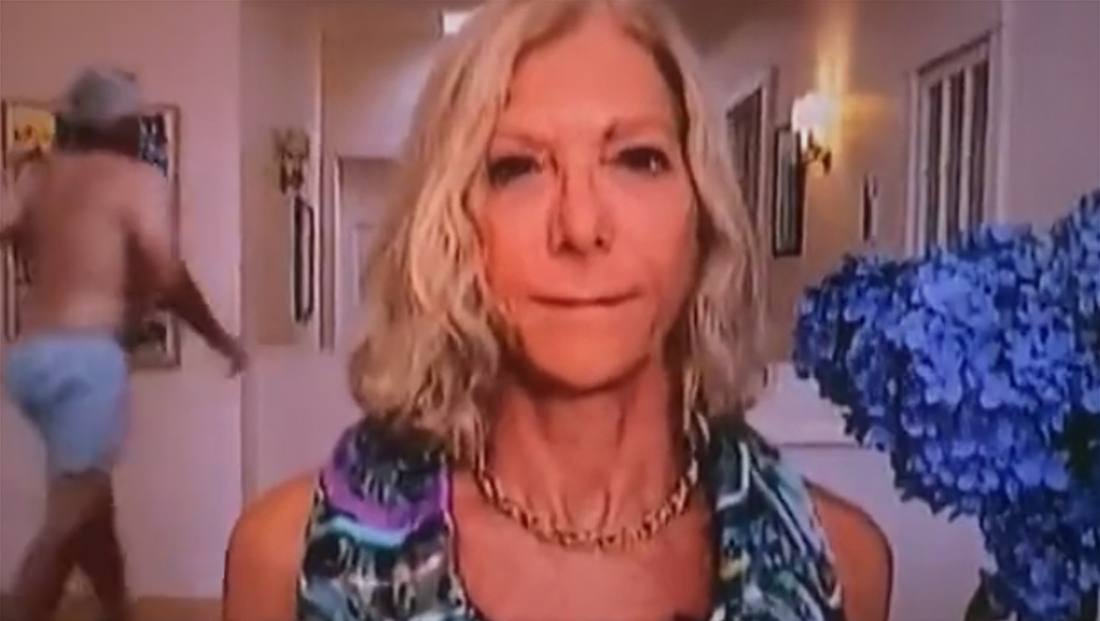Half-naked man upstages CNBC guest’s appearance
By MixDex Article may include affiliate links

Economist Karen Firestone was appearing CNBC’s “Squawk Box” when a half-naked man walked by in the background.
The July 18, 2022, segment went viral after viewers spotted a man in his underwear walk by in the background behind Firestone, who was appearing to discuss her theory that the U.S. economy may have already moved past a recession.
It was not immediately clear who the man was.
Firestone was by no means the first remote guest to find herself upstaged by a person in the background, pet or children. Other remote guests and talent have been caught on air without pants on or even vaping.
There’s also the pre-pandemic tale of the “BBC dad” whose children barged into the room where he was doing a live interview via video conferencing with the British broadcaster back in 2017.
Following a trend started during the COVID-19 pandemic in 2020, Firestone was appearing remotely from what appeared to be some kind of living space via some type of video calling technology.
There is a naked man on CNBC
– damn, everyday something new with these markets!https://t.co/rIxEnMADgD@andrewrsorkin @JoeSquawk @SquawkCNBC@Karen_Firestone pic.twitter.com/VnCBhKlCXA
— Russian Market (@russian_market) July 18, 2022
Once harder to find on network TV, remote reports and guest appearances via Skype, Zoom, FaceTime and other similar tools from peoples’ homes or offices soared in popularity during the pandemic and appear to be sticking around at least for the time being.
While the U.S. is currently battling another COVID-19 wave even as mask, vaccine and other requirements are rolled back, most TV reporters and anchors have returned to studios. At one point during the pandemic, even major network newscasts were originating from anchors’ homes (albeit with better technology than typical video-conferencing).
Before TV news more widely accepted video conferencing and calling tools as viable on-air solutions, guests and reporters typically had to travel to a TV studio in order to appear on a network’s air via professional satellite, fiber or other transmission technology. For guests, these shots were often done at local TV stations affiliated with the network in question.
It was largely accepted that home-based Internet connections did not have the bandwidth or reliability to send out professional-grade video. Home setups also typically lack higher quality lighting and sound.
Most of those issues were pushed aside during the pandemic as executives realized that viewers would accept the lower quality picture in exchange for the information the guest was conveying. At a time when the transmission of COVID-19 was still not well-understood, it was also essentially the only low-risk option if a show wanted to have guests.
If the trend continues, it has the added effect of making it easier to book guests on TV shows and opens the possibility of getting people who, due to geographic, scheduling and other challenges, might not be able to appear on TV.
It also typically allows people to appear as guests with less notice, making it easier to accommodate breaking news or changes to the news cycle.
COVID-19 vaccines and boosters are highly recommended by multiple public health officials and experts. COVID-19 vaccines and boosters have undergone extensive testing and monitoring to ensure their safety. Scientific research has shown the vaccines and boosters to be very safe and highly effective any may help stop you from contracting COVID-19 or resulting in less severe symptoms and chance of hospitalization or death. For more information about COVID-19 and coronavirus, visit the CDC website. You can locate a free vaccination site or clinic near you at Vaccines.gov. As with any medical decision, you should always discuss your options with your doctor.
Popular Searches
- TV Industry News
- Broadcast Engineering News
- Broadcast Design News
- TV Talk Shows
- TV Syndication
- TV Advertising
- TV News Jobs
- TV Industry Mergers and Acquisitions
- TV Anchors
- Cable News
- Late Night TV
- TV Syndication News
- Broadcast Industry News
- TV News Drone Journalism
- TV News Augmented Reality
- TV Weather Forecasting
- TV News Journalism
- TV News Ethics
- OTT News
- News About NBC
- News About CBS
- News About ABC
- News About CNN
- News About MSNBC
- News About Fox News

